SpringBoot + Mybatis-plus實戰(zhàn)之Mybatis-plus的一級緩存、二級緩存
前言
現(xiàn)在的JAVA行業(yè),貌似已經(jīng)是SpringBoot + SpringCloud 的天下了,早期的SSH,SSM框架已經(jīng)老去,與SpringBoot相結合的JPA框架雖然省去了很多的增刪改查sql,但是比較笨拙,在面對一些復雜多變的邏輯時常常力不從心,而相對應的Mybatis由于其高度的靈活性受到廣大JAVA攻城獅的歡迎。之前整合過了springboot+mybatis,前幾天看到一個面試的問一個問題,Mybatis的一級緩存,二級緩存。我想這個應該也是一個重點吧,所以今天決定來詳細解讀一下神秘的一二級緩存。
一級緩存是SqlSession級別的緩存。在操作數(shù)據(jù)庫時需要構造sqlSession對象,在對象中有一個數(shù)據(jù)結構(HashMap)用于存儲緩存數(shù)據(jù)。不同的sqlSession之間的緩存數(shù)據(jù)區(qū)域(HashMap)是互相不影響的。 一級緩存是默認開啟的不用配置。 二級緩存是mapper級別的緩存,多個SqlSession去操作同一個Mapper的sql語句,多個SqlSession可以共用二級緩存,二級緩存是跨SqlSession的。二級緩存的開啟(實體類必須序列化),然后在配置文件里面配置。MyBatis-plus 配置要點核心要點1
mybatis-plus 在springboot 中的核心配置如下
mybatis-plus.configuration.cache-enabled=truemybatis-plus.mapper-locations=classpath*:/mapper/*.xmlmybatis-plus.type-aliases-package=com.sch.app.mybatis.entitylogging.level.com.sch.app.mybatis.mapper= debug
所需依賴 除了基本的springboot依賴外,還有
核心要點2
<dependency> <groupId>com.baomidou</groupId> <artifactId>mybatis-plus-boot-starter</artifactId> <version>3.3.2</version></dependency><dependency><groupId>org.springframework.boot</groupId><artifactId>spring-boot-starter-cache</artifactId></dependency><dependency><groupId>org.projectlombok</groupId><artifactId>lombok</artifactId></dependency>
核心要點3
mybatis 語句生成 generatorConfig.xml 用它一步生成需要的基本實體類和接口以及mapper文件(resouses目錄下)
<?xml version='1.0' encoding='UTF-8'?><!DOCTYPE generatorConfiguration PUBLIC '-//mybatis.org//DTD MyBatis Generator Configuration 1.0//EN' 'http://mybatis.org/dtd/mybatis-generator-config_1_0.dtd'><generatorConfiguration> <!-- <properties resource='mybatis.properties' /> --> <classPathEntry location='D:AJavamysql-connector-java-8.0.16.jar' /> <context targetRuntime='MyBatis3'> <plugin type='org.mybatis.generator.plugins.SerializablePlugin'></plugin> <jdbcConnection connectionURL='jdbc:mysql://localhost:3306/alexshi?serverTimezone=GMT%2B8' driverClass='com.mysql.cj.jdbc.Driver' password='1234' userId='root' > <property name='nullCatalogMeansCurrent' value='true'/> </jdbcConnection> <javaTypeResolver> <property name='forceBigDecimals' value='false' /> </javaTypeResolver> <javaModelGenerator targetPackage='com.sch.app.mybatis.entity' targetProject='SpringbootMybatissrcmainjava'> <property name='enableSubPackages' value='true'/> <!-- 從數(shù)據(jù)庫返回的值被清理前后的空格 --> <property name='trimStrings' value='true' /> </javaModelGenerator> <sqlMapGenerator targetPackage='mapper' targetProject='SpringbootMybatissrcmainresources'> <property name='enableSubPackages' value='true'/> </sqlMapGenerator> <javaClientGenerator type='XMLMAPPER' targetPackage='com.sch.app.mybatis.mapper' targetProject='SpringbootMybatissrcmainjava'> <property name='enableSubPackages' value='true'/> </javaClientGenerator> <!--數(shù)據(jù)庫表--> <table schema='' tableName='d_dictionary'></table> <table schema='' tableName='d_dictionary_type'></table> <table schema='' tableName='c_resource'></table> <table schema='' tableName='c_role'></table> <table schema='' tableName='c_role_resource'></table> <table schema='' tableName='c_user_online'></table> <table schema='' tableName='c_user'></table> <table schema='' tableName='c_user_role'></table> <table schema='' tableName='test'></table> </context></generatorConfiguration>

這個 Run Mybatis Generator 可以在eclipse 的插件市場下的
點擊執(zhí)行后生成以下內(nèi)容
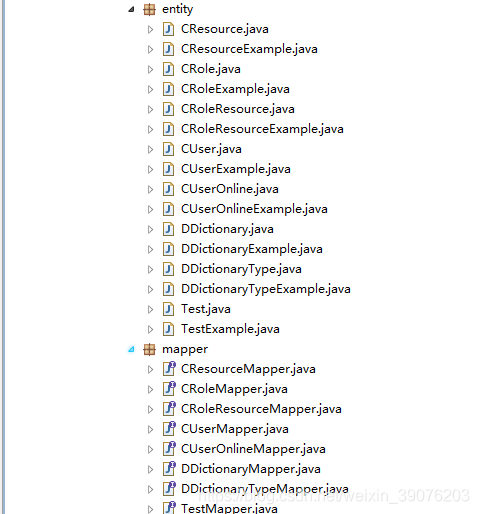
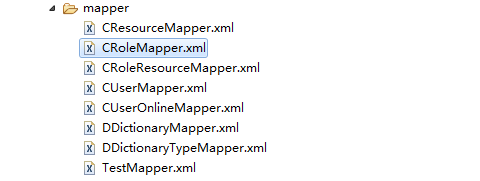
Mybatis-plus 一級緩存的測試
首先一定要開啟日志 方便查看效果
logging.level.com.sch.app.mybatis.mapper= debug
com.sch.app.mybatis.mapper 也就是 mapper接口的目錄
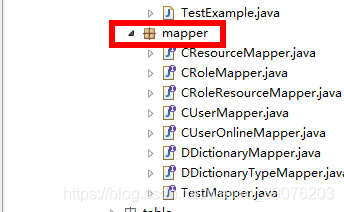
測試代碼1
@Autowiredprivate SqlSessionFactory sqlSessionFactory; @RequestMapping(value = '/testMybatis') @ResponseBody public void testMybatis(){ SqlSession sqlSession = sqlSessionFactory.openSession(); TestMapper testMapper = sqlSession.getMapper(TestMapper.class); for (int i = 0; i < 3; i++) { Test selectByPrimaryKey = testMapper.selectByPrimaryKey(5); log.info('結果:'+ selectByPrimaryKey.getUsername()); }
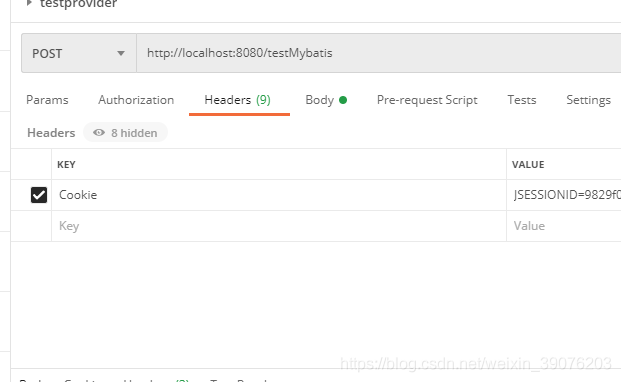
結果是

可以看出,只搜索了一次,第二三次都沒有sql打印
測試代碼2
@RequestMapping(value = '/testMybatis') @ResponseBody public void testMybatis(){ SqlSession sqlSession = sqlSessionFactory.openSession(); TestMapper testMapper = sqlSession.getMapper(TestMapper.class); for (int i = 0; i < 3; i++) { Test selectByPrimaryKey = testMapper.selectByPrimaryKey(5); log.info('結果:'+ selectByPrimaryKey.getUsername()); if (i == 2) { selectByPrimaryKey.setUsername('劉惜君的妹妹'); testMapper.updateByPrimaryKey(selectByPrimaryKey); Test selectByPrimaryKey2 = testMapper.selectByPrimaryKey(5); log.info('更新后的用戶名:'+ selectByPrimaryKey2.getUsername());} }
打印結果:

可見,第一次我加入了更新的代碼后再次查詢的時候,就又執(zhí)行了sql語句,說明當執(zhí)行插入、更新、刪除,會清空SqlSession中的一級緩存。只有查詢的操作,一級緩存才不會被清除。
Mybatis-plus二級緩存測試
二級緩存的開啟除了在配置文件中打開開關 還要在mapper對應開啟
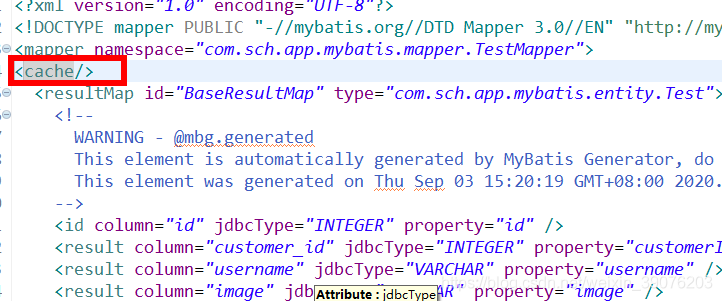
測試代碼1
@RequestMapping(value = '/testMybatis2') @ResponseBody public void testMybatis2(){ SqlSession openSession1 = sqlSessionFactory.openSession(); SqlSession openSession2 = sqlSessionFactory.openSession(); TestMapper mapper1 = openSession1.getMapper(TestMapper.class); TestMapper mapper2 = openSession2.getMapper(TestMapper.class); Test selectByPrimaryKey = mapper1.selectByPrimaryKey(5); System.out.println(selectByPrimaryKey.getUsername()); openSession1.close(); Test selectByPrimaryKey2 = mapper2.selectByPrimaryKey(5); System.out.println(selectByPrimaryKey2.getUsername()); openSession2.close(); }
測試結果

由測試結果可知,上述代碼第一次查 mapper1.selectByPrimaryKey(5) 的時候執(zhí)行了sql,然后關閉了第一個session 第二次 用別的sqlseeison 去查沒有調(diào)用sql,說明了二級換粗和sqlseesion 無關,之和mapper有關。
測試代碼2
@RequestMapping(value = '/testMybatis3') @ResponseBody public void testMybatis3(){ SqlSession openSession1 = sqlSessionFactory.openSession(); SqlSession openSession2 = sqlSessionFactory.openSession(); SqlSession openSession3 = sqlSessionFactory.openSession(); TestMapper mapper1 = openSession1.getMapper(TestMapper.class); TestMapper mapper2 = openSession2.getMapper(TestMapper.class); TestMapper mapper3 = openSession3.getMapper(TestMapper.class); Test selectByPrimaryKey = mapper1.selectByPrimaryKey(5); System.out.println(selectByPrimaryKey.getUsername()); openSession1.close(); selectByPrimaryKey.setUsername('劉惜君的姐姐'); mapper2.updateByPrimaryKey(selectByPrimaryKey); openSession2.commit(); Test selectByPrimaryKey3 = mapper3.selectByPrimaryKey(5); System.out.println(selectByPrimaryKey3.getUsername()); openSession3.close(); }
打印結果

由此可知,做了更新mapper2.updateByPrimaryKey(selectByPrimaryKey); 之后, 二級緩存才被清空。特性和一級緩存很類似。
初次之外,我們可以通過userCache是來設置具體的語句是否禁用二級緩存

重新執(zhí)行 http://localhost:8080/testMybatis2 后的打印結果

可見 selectByPrimaryKey 這個查詢禁止二級緩存后,兩次都從數(shù)據(jù)庫里面查了。
小結
一級緩存是默認開始的,屬于會話級別,一個會話做多次做相同查詢會開啟,如果對查詢的數(shù)據(jù)進行更新,刪除等操作時,再次查詢會從數(shù)據(jù)庫里查而不用一級緩存。 二級緩存開啟最重要,請記住三點,1.配置文件開啟mybatis-plus.configuration.cache-enabled=true,2.對應mapper文件開啟 3.對應實體類實現(xiàn)Serializable 接口。如果要對某一個sql語句禁用二級緩存,則需要在具體的xml 的sql語句定義處加上 useCache=“false” 。另外記住它和會話無關,和 xml 的 namespace 即具體的mapper 有關。 在mapper的同一個namespace中,如果有其它insert、update、delete操作數(shù)據(jù)后需要刷新緩存,如果不執(zhí)行刷新緩存會出現(xiàn)臟讀。 設置statement配置中的flushCache=“true” 屬性,可以實現(xiàn)二級緩存的刷新,false則可能出現(xiàn)臟讀。openSession.clearCache() 可以實現(xiàn)對一級緩存的刷新。到此這篇關于SpringBoot + Mybatis-plus實戰(zhàn)之Mybatis-plus的一級緩存、二級緩存的文章就介紹到這了,更多相關Mybatis-plus一級緩存、二級緩存內(nèi)容請搜索好吧啦網(wǎng)以前的文章或繼續(xù)瀏覽下面的相關文章希望大家以后多多支持好吧啦網(wǎng)!
相關文章:

 網(wǎng)公網(wǎng)安備
網(wǎng)公網(wǎng)安備